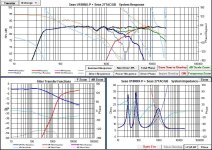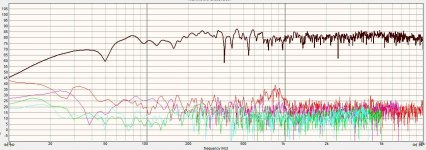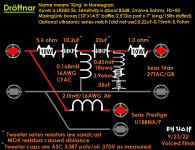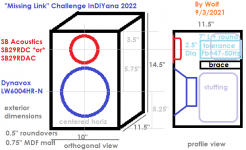In the Spring, I finished the Missing Link boxes for the InDIYana 2022 xover theme with the added objective of using it for more upcoming 7" 2way type build stand-mount projects.
Most of you have likely seen the first use with the SB29RD(A)C and Dynavox LW6004HRN. This is the second one, using the Seas U18 and 27TAC Titan tweeter. The 50 Hz tuning and stuffed 15 ltr box was good for the U18. If I tuned lower, it would sound a bit anemic, but the highish tuning used supported the bottom end fairly well.
I used the first of my 2 pair of Titans in the EMP build recently in the last couple years, and this is now the second implementation of a tweeter I really enjoy a lot. What is posted here for FR and HD is prior the addition of a 1 ohm resistor after the xover on the tweeter to adjust to taste. It was flat before, but just a hair bright, so just eyeball about a -1dB tilt above 2.5k.
The xover ended up being LR2 at 2.5kHz, which is one of only a couple times I've managed that result. Because of this, the toe-in needs to be just a bit more than normal to get the image right and not shift when moving my head. I literally can look down the outer left and outer right sides of the respective channels when seated in the right spot. To get the drivers to comply at LR2 took a single coil on the woofer and an overdamped 3rd order on the tweeter with an additional Fs LCR compensation. The TAC has no ferroFluid, and this is a likely compensation circuit to add in most cases.
Some funny/interesting things that occurred over the course include;
Listening impressions? I feel they are really revealing without being harsh. That said though,they are okay with rock, jazz, country, orchestral, classical, etc; but I would not recommend them as metal speakers. Being that they reveal the flaws, the source material really needs to be clean to sound right. Those of us Metalheads know that over compressed and gritty can be quite common for the bad mixes. With well recorded metal, I would still think they'll sound quite good. Nightwish's 'Dark Passion Play' was fine for example, but Born of Osiris was not.
For the parts used, in case you're curious, I used ASC X387 poly-in-oil caps for the tweeter, and I hand wound a 16AWG air-core for the woofer that I triple-dipped in polyurethane. Sandcast resistors used throughout.
Thanks for reading my long winded intro to my 'King' Norwegian design.
Wolf
Most of you have likely seen the first use with the SB29RD(A)C and Dynavox LW6004HRN. This is the second one, using the Seas U18 and 27TAC Titan tweeter. The 50 Hz tuning and stuffed 15 ltr box was good for the U18. If I tuned lower, it would sound a bit anemic, but the highish tuning used supported the bottom end fairly well.
I used the first of my 2 pair of Titans in the EMP build recently in the last couple years, and this is now the second implementation of a tweeter I really enjoy a lot. What is posted here for FR and HD is prior the addition of a 1 ohm resistor after the xover on the tweeter to adjust to taste. It was flat before, but just a hair bright, so just eyeball about a -1dB tilt above 2.5k.
The xover ended up being LR2 at 2.5kHz, which is one of only a couple times I've managed that result. Because of this, the toe-in needs to be just a bit more than normal to get the image right and not shift when moving my head. I literally can look down the outer left and outer right sides of the respective channels when seated in the right spot. To get the drivers to comply at LR2 took a single coil on the woofer and an overdamped 3rd order on the tweeter with an additional Fs LCR compensation. The TAC has no ferroFluid, and this is a likely compensation circuit to add in most cases.
Some funny/interesting things that occurred over the course include;
- I heard more details in some tracks I know really well, and that is saying something. This is a VERY clean design. It has lower HD than a lot of my other builds, dominantly -50dB for the most part.
- I had some sssibilance initially when I added the second resistor, which was a MOX Lynk type. I changed to a sandcast, and the problem subsided.
- I have some very small Russian polystyrene caps of 0.002uF. I paralleled the tweeter caps with them just to hear the results and had no expectations. They are very small in value. Well- I removed them after a first listen as the tweeters sounded broken, disjointed, and distorted badly. I really thought I might have had a bad tweeter because of what I was hearing. After removal, the relaxed and detailed sound that I heard prior returned as I had left it. I'm not really sure what caused the bad interaction, but it was awful!! I am not a supporter of bypassing for the most part, but since I had them and they were doing nothing I gave them a shot.
Listening impressions? I feel they are really revealing without being harsh. That said though,they are okay with rock, jazz, country, orchestral, classical, etc; but I would not recommend them as metal speakers. Being that they reveal the flaws, the source material really needs to be clean to sound right. Those of us Metalheads know that over compressed and gritty can be quite common for the bad mixes. With well recorded metal, I would still think they'll sound quite good. Nightwish's 'Dark Passion Play' was fine for example, but Born of Osiris was not.
For the parts used, in case you're curious, I used ASC X387 poly-in-oil caps for the tweeter, and I hand wound a 16AWG air-core for the woofer that I triple-dipped in polyurethane. Sandcast resistors used throughout.
Thanks for reading my long winded intro to my 'King' Norwegian design.
Wolf
Attachments
I forgot the most important one! The Speakers!
JR snapped this photo at the CSS/Meniscus shindig this past weekend.

I know they don't look like much being MDF with 2 coats of epoxy, but they do sound very good.
JR snapped this photo at the CSS/Meniscus shindig this past weekend.
I know they don't look like much being MDF with 2 coats of epoxy, but they do sound very good.
I found that the last removable baffle bookshelf I did had considerable flex at the midline due to bolts in the 4 corners. Due to that, this one has 6 bolts and fixed the possible problem before it happened.
The reason they are hex head bolts is that I stripped out the finish-head furniture bolts I used before, and I had these on hand in the garage. They worked very well!
The reason they are hex head bolts is that I stripped out the finish-head furniture bolts I used before, and I had these on hand in the garage. They worked very well!
A nice black or white fabric cover on that baffle, get some decent furniture screws and you're done. Nice work.
Last edited:
Hi Wolf - do you bother with off-axis simulation and measurements? if not, why not? Just curious (not a loaded question - always learning).
Omnimic/PCD doesn’t model for off-axis, but acoustic LR2 @2.5Khz is the sweet spot for drivers this size, particularly if the drivers are as smooth and extended as the U18.
For decades Wolf’s ear has been assessing what we’ve only started being able to measure in the past few years (horizontal and vertical off-axis out to +/- 180 degrees and thus power response and predicted in room response)
Another job well done Ben!
For decades Wolf’s ear has been assessing what we’ve only started being able to measure in the past few years (horizontal and vertical off-axis out to +/- 180 degrees and thus power response and predicted in room response)
Another job well done Ben!
Last edited:
PCD does the Power Response model, the green curve. It's a best fit sum of all the supposed axes in one plot. You can also toggle off axis left and right or up and down or both at the same time using piston diameters. In terms of modeling on this build, that's about all I did here.Hi Wolf - do you bother with off-axis simulation and measurements? if not, why not? Just curious (not a loaded question - always learning).
If you look at other builds like the Purveyor as an example, I did quite a few off axis measurements in Omnimic. It just takes a lot of time.
So, yes, I do take off axis into account. However, I feel the primary axis reveals the most about a design.
As I said above, it sorta can, and I've used it this way a lot. Thing is, the U18 just won't do LR4 simply. The response will not allow it. I did try to see if it would. LR2 is simple with just a coil. I'm not opposed to lower slopes/orders, but this is an atypical convention for most drivers. The U18 will even be capable of a 3k xover if desired.Omnimic/PCD doesn’t model for off-axis, but acoustic LR2 @2.5Khz is the sweet spot for drivers this size....
For decades Wolf’s ear....
Thanks for the compliments and the trust in my findings, Thanh! It is much appreciated.
Hi Ben, I enjoyed reading about this design. There seem lots of good aspects about the Curv range.
I think you said that you also know the U16 + M/FU10, too. How do you think this driver range stands up to current competition?
Have you since managed to hear the U22?
When you mentioned you that the U18 response does not allow LR4; what's going on that makes this hard?
Thanks.
I think you said that you also know the U16 + M/FU10, too. How do you think this driver range stands up to current competition?
Have you since managed to hear the U22?
When you mentioned you that the U18 response does not allow LR4; what's going on that makes this hard?
Thanks.
I really like the Curv drivers. They are very light in mass, and yet very well damped with minimal breakup. They do however have a little flex to the material, so are not the most pistonic for the best bass response. Since the minimal breakup follows, this means that the networks don't require excessive conjugates to make it behave. Back to the flexing cone though, you can see the rise in HD around 800Hz, and this cancellation and minor wooliness is audible and really the only minor flaw. It does not sound bad. The U18 has a very smooth sound, with the right weight in the lower mids, and detailed midbass.
The U16 has a little more breakup than the U18, and depending on system requirements might need compensation for it. I think it tends to be a little more punchy in bass tone than the U18. I have not heard the U22, but would like to.
The FU10RB 8 ohm I'll be using in a new build, but I've had them awhile. I was having a problem with it's sensitivity being too low everytime I entertained using it, and that it actually did not meet spec. Granted, my pair are used, but that should not have been an issue. I ended up adding holey Neo magnets to the backplate to get it to make or exceed output spec. Hifi Compass shows it has a blemish at about 1.5k of minor HD magnitude. I will have to see how that looks in application.
As to the rolloff of the U18 being preferably LR2, the rolloff with a single coil simply matches LR2. You would have to use a 3rd order and some clever compoents to yield the LR4 match. Most woofers do not meet LR2 or even a quasi 1st order (tapers to 3rd order acoustic outside xover with in phase and -6dB summation) acoustic xover result easily, and favor an LR4. This is one of the rare birds that do it well. If the tweeter can do it too, which can be a tough endeavor in a lot of cases, it is indeed a rare combination. Tweeters work harder to play with an LR2 result than a typical LR4.
The U16 has a little more breakup than the U18, and depending on system requirements might need compensation for it. I think it tends to be a little more punchy in bass tone than the U18. I have not heard the U22, but would like to.
The FU10RB 8 ohm I'll be using in a new build, but I've had them awhile. I was having a problem with it's sensitivity being too low everytime I entertained using it, and that it actually did not meet spec. Granted, my pair are used, but that should not have been an issue. I ended up adding holey Neo magnets to the backplate to get it to make or exceed output spec. Hifi Compass shows it has a blemish at about 1.5k of minor HD magnitude. I will have to see how that looks in application.
As to the rolloff of the U18 being preferably LR2, the rolloff with a single coil simply matches LR2. You would have to use a 3rd order and some clever compoents to yield the LR4 match. Most woofers do not meet LR2 or even a quasi 1st order (tapers to 3rd order acoustic outside xover with in phase and -6dB summation) acoustic xover result easily, and favor an LR4. This is one of the rare birds that do it well. If the tweeter can do it too, which can be a tough endeavor in a lot of cases, it is indeed a rare combination. Tweeters work harder to play with an LR2 result than a typical LR4.
Well done.. Particular care for the passive parts choice for voicing as usual. Good to read for the ones thinking caps and resistors are all the same.
A translation problem: what exactly "clarity" is meaning in english when speaking about loudspeakers, please ? Is that equivalent to : "clean", "transparent" or "detailled". In my native language it could mean both : "clean" as no cloud for instance, so you have a deep vision, BUT at the same time "full of ligth" (in spite of "cloudy" i.e. "somber") ... so meaning as well a lack of weigth and matiness (tirering listening).
If I translate between two caps just for illustration : Audyn Cap Plus or Jantzen Silver are : "very clear" VS a a Clarity PX or a Mundorf Supreme...
Is clarity word for our hobby purpose is the opposite of "smooth" then ?
Sorry for the sligthy off topic, just to say for non english natives, the word "clarity" can be confusing . 🙂
Thanks for the design and sharing btw.
A translation problem: what exactly "clarity" is meaning in english when speaking about loudspeakers, please ? Is that equivalent to : "clean", "transparent" or "detailled". In my native language it could mean both : "clean" as no cloud for instance, so you have a deep vision, BUT at the same time "full of ligth" (in spite of "cloudy" i.e. "somber") ... so meaning as well a lack of weigth and matiness (tirering listening).
If I translate between two caps just for illustration : Audyn Cap Plus or Jantzen Silver are : "very clear" VS a a Clarity PX or a Mundorf Supreme...
Is clarity word for our hobby purpose is the opposite of "smooth" then ?
Sorry for the sligthy off topic, just to say for non english natives, the word "clarity" can be confusing . 🙂
Thanks for the design and sharing btw.
Put a heavy blanket over a speaker, sound is not clear. Take blanket off, sound is clear.
Clear is not the opposite of smooth. Opposite of clear is muffled, muddy, veiled.
Listen to e.g. Luxman/tubes + e.g. Harbeth speakers - midrange is smooth but maybe not always crystal clear.
Listen to class D + KEF/B&W/Revel - midrange is 💩 🤣 but not unclear
Clear is not the opposite of smooth. Opposite of clear is muffled, muddy, veiled.
Listen to e.g. Luxman/tubes + e.g. Harbeth speakers - midrange is smooth but maybe not always crystal clear.
Listen to class D + KEF/B&W/Revel - midrange is 💩 🤣 but not unclear
Last edited:
ok, so in my native language when talking loudspeaker, "clear" is meaning "transparent" .
"Detailled" is something else, i.e. : more informations (details).
Thanks. Motokok... seems you need polypro based à la Harberth or AudioSkaaning, Dynaudio 😉 midrange ! (or aerogel à la Audax)
I can confirm woven carbon from Seas are good sounding and non fatiguing having had that from the Excell serie in a Proac D15.
"Detailled" is something else, i.e. : more informations (details).
Thanks. Motokok... seems you need polypro based à la Harberth or AudioSkaaning, Dynaudio 😉 midrange ! (or aerogel à la Audax)
I can confirm woven carbon from Seas are good sounding and non fatiguing having had that from the Excell serie in a Proac D15.
Last edited:
my first attempt. I never use this VituixCAD before. this is traced Seas 27TAC/GB FRD ZMA
https://file.io/LRsjXkZhlpaF
https://file.io/LRsjXkZhlpaF
Nice little speakers! FYI, some other implementation of the same drivers: https://www-donhighend-de.translate...l=auto&_x_tr_tl=de&_x_tr_hl=de&_x_tr_pto=wapp
Please upload the file here. Rename with a .txt extension and it should upload okmy first attempt. I never use this VituixCAD before. this is traced Seas 27TAC/GB FRD ZMA
https://file.io/LRsjXkZhlpaF
- Home
- Loudspeakers
- Multi-Way
- Dröttnar- A SEAS U18RNX/P and 27TAC/GB 2way with exceptional clarity...




